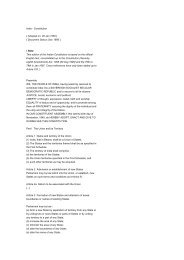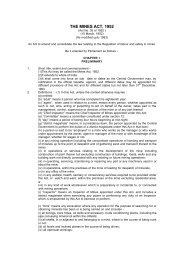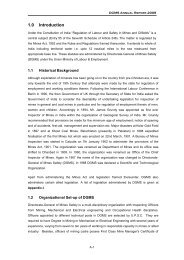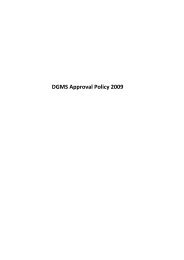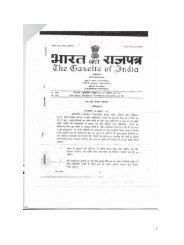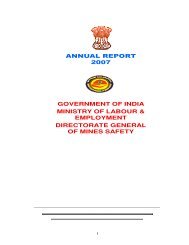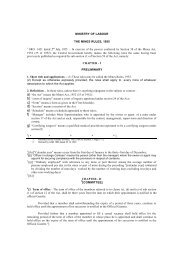Metalliferous Mines Regulations, 1961 - Directorate General of ...
Metalliferous Mines Regulations, 1961 - Directorate General of ...
Metalliferous Mines Regulations, 1961 - Directorate General of ...
Create successful ePaper yourself
Turn your PDF publications into a flip-book with our unique Google optimized e-Paper software.
winding, the end <strong>of</strong> the rope shall be securely fixed in such a manner that the rope is not unduly strained.<br />
There shall be at least two turns <strong>of</strong> the rope on the drum when the cage or other means <strong>of</strong> conveyance is at<br />
its lowest working point in the shaft or winze.<br />
(2)(a) There shall be provided one or more brakes on the drum which :<br />
(i)<br />
(ii)<br />
if there are two cages or other means <strong>of</strong> conveyance, will hold such cages or other means <strong>of</strong><br />
conveyance when the maximum torque is applied in either direction; or<br />
if there is only one cage or other means <strong>of</strong> conveyance, will hold the loaded cage or other means<br />
<strong>of</strong> conveyance in midshaft when the maximum torque is applied downwards.<br />
(b) At least one <strong>of</strong> the brakes shall be so designed that the brake remains at the ‘on’ position except when<br />
operated.<br />
(c) Where the brake or brakes are power-operated, at least one <strong>of</strong> them shall be arranged to be applied<br />
automatically at all times if the power supply fails. In no case shall a brake be operated by an auxiliary<br />
electric current.<br />
(d) The brake on the drum shall be used only for the purpose <strong>of</strong> keeping such drum stationary and not for<br />
lowering the cage or other means <strong>of</strong> conveyance, except in cases where the engine is to be worked at a<br />
very low speed as when examining the winding rope or the shaft or winze.<br />
(3) Where the winding engine is worked by steam or compressed air, a screw stop-valve shall not be used<br />
as controlling valve <strong>of</strong> the engine.<br />
(4) Every engine shall be equipped with a reliable depth-indicator (in addition to any mark on the rope)<br />
showing to the winding engineman the position <strong>of</strong> the cage or other means <strong>of</strong> conveyance in the shaft, and<br />
an automatic device that will ring a bell in the engine room when the ascending cage or other means <strong>of</strong><br />
conveyance is at a distance <strong>of</strong> not less than two revolutions <strong>of</strong> the drum from the top <strong>of</strong> the shaft or winze.<br />
The depth-indicator shall be tested after every adjustment or replacement <strong>of</strong> the winding rope.<br />
83. Shaft fittings – At every winding shaft, other than a shaft in the course <strong>of</strong> being sunk – to which the<br />
provisions <strong>of</strong> regulation 87 shall apply – the following provisions shall have effect, namely:<br />
(1)(a) Efficient means shall be provided and maintained for interchanging separate, distinct and definite<br />
signals between the top <strong>of</strong> the shaft or winze and –<br />
(i)<br />
(ii)<br />
the bottom or other permanent landing <strong>of</strong> the shaft; and<br />
every inset for the time being in use.<br />
There shall also be provided and maintained efficient means for transmitting such signals from the top <strong>of</strong><br />
the shaft to the winding engineman. All signals shall be transmitted by mechanical or electrical means.<br />
(b) In signalling, the following code <strong>of</strong> signals shall be used and strictly observed :<br />
ONE RAP : STOP<br />
TWO RAPS : LOWER<br />
THREE RAPS : RAISE<br />
FOUR RAPS : MEN ready to ascend or descend<br />
FOUR RAPS : IN REPLY – men may enter the cage or other means <strong>of</strong> conveyance.<br />
Anyother signals shall be addition to, and shall not interfere with, the foregoing.<br />
Provided that the Chief Inspector may, by an order in writing and subject to such conditions as he<br />
may specify therein, permit the use <strong>of</strong> any code <strong>of</strong> signalling other than that specified above.





